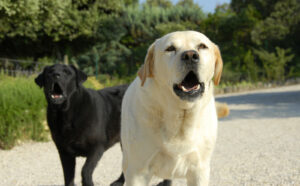Barks Blog
Dog Owner Confidence Crash!

There’s so much written about emotions of our dogs, how they’re thinking and what they’re feeling in various provocative situations and scenarios, but sometimes I think we, the dog owners, may end up being a little neglected! You can’t successfully help dogs with behavioral or training issues alone; you also have to see how they interact with their owner/dog guardian and what that relationship is. It’s a complex dynamic. One component of that incredibly complicated relationship I want to bring to the fore here though is confidence – one small word, but with massive impact.
Confidence?
Confidence – that certainty that you have conviction or faith, trust in yourself that you can do this! In the doggy context, those training goals, those behavior modification plans will work, you have that positivity in yourself and your dog. The issue though is that confidence is like a brittle wall and it can take one small, one tiny little thing and that wall can be smashed though quite easily. Of course, the strength of the ‘wall of confidence’ depends upon individual characteristics – some of us are more resilient and tolerant than others, that will be always the case, but I know first hand when working with clients, even in these cases, how fragile confidence is and it doesn’t take much for that wall to be knocked down. Confidence is an easy wall to be smashed through and not an easy one to rebuild, granted, but here’s how to limit those confidence crashes.
Overly-Aroused Dogs
I’m going to start with this example because it’s the most personal to me and I have lots of first-hand experience. By arousal and as a very simply explanation, I mean dogs who are aware of and responsive to their environment and absolutely everything that’s in it. Dogs that are overly aroused are on overdrive in terms of their response, so they may be extremely exuberant with people/dogs very barky, lunge at other dogs/vehicles/livestock/people, appear anxious or fearful etc. There is a very long list of possible symptoms. The key with over-arousal also is that it takes time for the dog to calm after exposure to specific triggers. Such dogs are often given labels – naughty, out of control, wild, hard to handle, delinquent, dominant, alpha etc. when in fact they’re incredibly stressed by the environment they’re in and are finding it hard to cope. What doesn’t help is when owners are berated and blasted with such labels when they’re tying their hardest to assist their dog – immediate confidence loss. A dog like this cannot be bullied or rough-housed, they require kind and sympathetic handling. If your dog is struggling in this way, it is extremely difficult for the owner because the issues are highly visible and you feel like everybody else’s dog is perfect! To start with though, try not to place your dog in provocative situations, understand what scenarios are difficult and listen to your dog.
Training ‘Fails’
Okay, so your session may be going well, perhaps you have been training recall to good effect, a few great rockets back and forth and then a dog appears and yours has whooshed to greet him – ughh moment. Try not to focus on the last ‘whoosh and go’ but the positive session just before. Analyse why your dog ran off – not out of “naughtiness” but simply a greeting and all normal. Perhaps you can now think about next time training in a slightly less distracting area so that the social competitions are less. You may also think about, okay, so he ran off, how can I work on now calling him back from normal play?
Quit While You’re Ahead
This is a very common one. It’s human nature to push it. Stop while your dog is doing well, don’t prolong your session just because you’re having good time, you haven’t been out long or you think he should meet just one more dog. This can be especially common with dog desensitization cases I see, just one dog too many when the clients dog is already ‘dog satiated’, and then more than likely a bad session is reported.
Don’t Set Your Dog Up To Fail
I think this can be done without realizing. You have to listen to your dog and recognize signs of stress, something we don’t do enough of. A prime example here is when behavior clients report slow progress and become disheartened. Commonly the dog is being pushed too fast e.g. during sound desensitization recordings where the volume is increased too quickly and the dog is distressed or where an anxious dog is encouraged to meet visitors to the home she doesn’t know, when it would have been far more preferable to allow her to reside in a comfy bolt hole.
Don’t Be Afraid To Step Backwards
We all have to do this at some stage. We should not compare ourselves, our progress or our dogs with others or allow that to happen. If we need to go back to using long lines, crates or other equipment, so be it. Many dog guardians become a little disheartened as their dog reaches adolescence – that big hormone surge when confidence increases. Sometimes training slides back a little, that’s normal, we just increase training efforts, it doesn’t mean all is lost.
Confidence Crash and Our Dogs
Our dogs need us to be positive, to give clear signals and directions. I know that the moment I become flustered, lose confidence when competing with my dog, that he immediately senses this and he makes poor choices (as do I).
The moment you sense something is not going to plan, do something about it. Seek help from a qualified and force-free trainer and behaviorist who will identify what your dog’s issues are and will assist both of you. This is vitally important as the relationship between you and your dog is unique.

